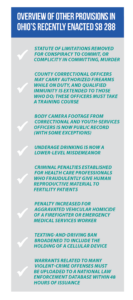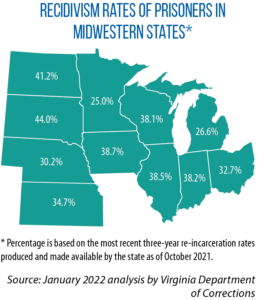Ohio begins new chapter in justice policy after passage of far-reaching bill in late 2022; priorities include reducing recidivism, improving reentry
Ohio’s most recent attempt to improve its criminal justice system started with lawmakers gathering a “wish list.”
Shortly after Sen. Nathan Manning was named chair of the Senate Judiciary Committee in 2021, he received marching orders from Senate President Matt Huffman to pass a good omnibus criminal justice bill.
 From there, Manning and others met with multiple well-known stakeholders in the criminal justice policy realm to better understand what strategies could improve the justice system — be they new ideas, or ideas from older pieces of legislation that failed to pass.
From there, Manning and others met with multiple well-known stakeholders in the criminal justice policy realm to better understand what strategies could improve the justice system — be they new ideas, or ideas from older pieces of legislation that failed to pass.
“We didn’t really have an agenda except for the fact that we really wanted, at least to a certain extent, to focus on collateral sanctions [hurting] people who have turned their lives around,” he says.
“We want to help them become productive members of society and not have this necessarily hanging over their head and limit where they can get jobs.”
All of those talks eventually materialized into SB 288, a measure passed in December during Ohio’s lame-duck session. Although SB 288 incorporated several last-minute amendments, the core of the bill represented years of negotiations and work on its myriad provisions to reduce recidivism by easing the transition for people leaving prison.
Among the goals: increase opportunities for incarcerated individuals to earn time off from their sentences and ease the process for sealing or expunging criminal records.
Previously, the amount of time that an incarcerated offender could take off their sentence in exchange for obtaining earned credits could not exceed a length of days equivalent to 8 percent of their total sentence. The ceiling is now 15 percent.
Credits can still be earned by participating in educational programs, vocational training and substance abuse therapy, as well as by securing a high school equivalency certificate. “Ohio was either one of the lowest or possibly the lowest [in the country] in earned credit at 8 percent,” Manning says.
The law also allows more than one eligible felony criminal record to be sealed at a time and caps filing fees at $50. Fees are waived altogether if the applicant provides a poverty affidavit.
For those seeking to have their records expunged, the law creates an application process such as the one already used for record sealing. The chance to erase records, via expungement, can be a valuable alternative to sealing, Manning says.
 “I’ve seen that as an attorney where we get a client’s record sealed, for somebody who is really turning their life around and even situations where maybe somebody wants to hire them, but for whatever reason they can’t because the sealed record still comes up,” Manning says.
“I’ve seen that as an attorney where we get a client’s record sealed, for somebody who is really turning their life around and even situations where maybe somebody wants to hire them, but for whatever reason they can’t because the sealed record still comes up,” Manning says.
Additionally, prosecutors now can personally apply to seal or expunge conviction records related to a low-level drug offense.
Reentry 2030: CSG part of new national initiative
Reducing recidivism also is the goal of Reentry 2030, a recently launched national initiative being co-led by the CSG Justice Center, the Correctional Leaders Association and JustLeadershipUSA.
“One of the challenges with reentry is that when people return, multiple systems touch them,” says Nicole Jarrett, director of the CSG Justice Center’s Corrections and Reentry Division.
 “The way we typically think about reentry is that it’s a corrections challenge or issue. But really, for successful reentry to happen, people need basics like housing. They need a job. If they have substance abuse needs, they need treatment.”
“The way we typically think about reentry is that it’s a corrections challenge or issue. But really, for successful reentry to happen, people need basics like housing. They need a job. If they have substance abuse needs, they need treatment.”
Reentry 2030 asks state leaders and stakeholders alike to think about the logistics of reintegration more broadly, and to let shared data drive policymaking, Jarrett says. In part, this evidence-based approach involves identifying barriers to employment and other essentials of well-being that can make reintegration a self-defeating exercise.
And it also means listening.
“There’s been a growing movement around having people with lived experience share what the reentry process has looked like for them,” Jarrett says. “People who’ve gone through it will be the first ones to tell you all the inefficiencies. … They know because they’re the common element across all of these well-meaning systems, and programs, and organizations.”
The conversation on reentry and what it means for a former offender to find fulfillment needs to go beyond just reducing recidivism, she says, adding this means gaining a better understanding of existing racial and ethnic inequities in reentry success.
 According to Jarrett, the new Ohio law’s emphasis on encouraging participation in pre-release programming is promising.
According to Jarrett, the new Ohio law’s emphasis on encouraging participation in pre-release programming is promising.
The challenge for Ohio and other states, she adds, is finding ways to scale up correctional programming, remove long waiting lists for services, expand participant eligibility, and then continue rehabilitation post-release through community programming and employer partnerships.
Strangulation now a felony under new Ohio law
SB 288 touches on many other aspects of Ohio’s criminal justice system. For instance, lawmakers revised their laws in response to the epidemic of drug overdoses and deaths.
First, the new law expands “Good Samaritan” protections for individuals who seek help when witnessing an overdose. These individuals will not be prosecuted if drug paraphernalia is found on them by police responding to the overdose. Second, legislators decriminalized the possession of fentanyl test strips, which can be used to detect the presence of fentanyl (tied to many overdose deaths) in drugs.
Another part of SB 288 marks a legislative victory for lawmakers such as Sens. Nickie Antonio and Stephanie Kunze, who had long sought a change in the state’s law on strangulation.
Now, strangulation in Ohio is considered a felony offense (it had not been prior to SB 288’s passage), much as it is in 48 other states. The result is increased penalties for domestic abusers.
Antonio says some resistance over the years to a statutory change stemmed from concerns that increasing the criminal severity of strangulation would unintentionally harm “boys roughhousing.” “This is so clearly not that,” she adds.
 Antonio referenced testimony in multiple committee hearings about the physical damage of strangulation, as well as the potential for future violence by people who commit the crime.
Antonio referenced testimony in multiple committee hearings about the physical damage of strangulation, as well as the potential for future violence by people who commit the crime.
A study by Johns Hopkins University, for example, found that a person who has been non-fatally strangled even once by his or her domestic partner is 750 percent more likely to later be murdered by that same partner. Unlike previous bills where the focus was solely on domestic abuse cases, SB 288 includes tiered penalties based on whether the perpetrator is related to the victim or is a repeat offender for all instances of strangulation.
Antonio credits the provision’s inclusion in a larger omnibus bill as the reason it finally crossed the finish line:
“My hope is that with stopping it at the point of strangulation the very first time … there are a lot of lives to be saved. And maybe the perpetrator can get some help, too [while being incarcerated].”